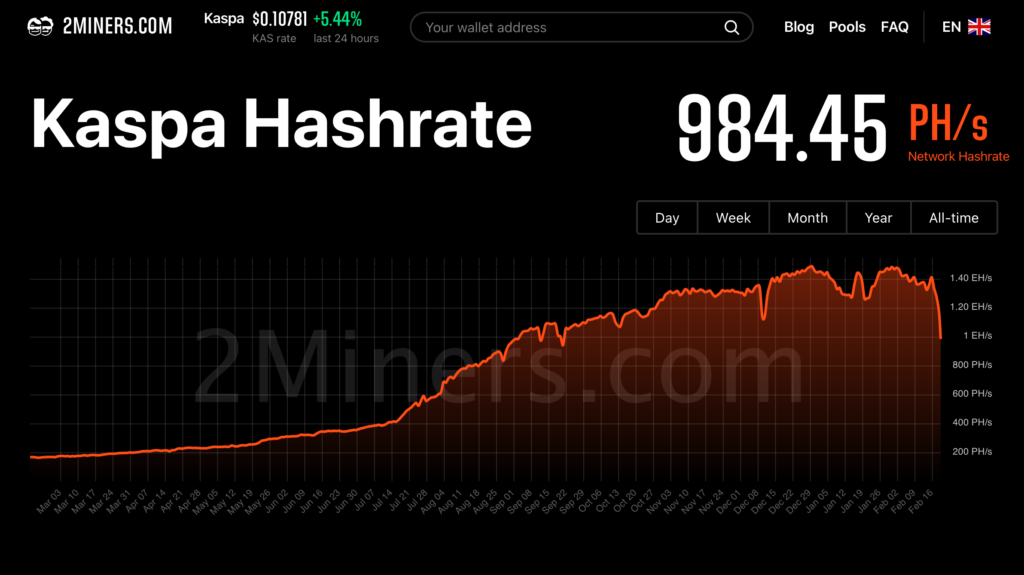Today Kaspa has experienced a sudden hashrate decline, dropping from 1.3 PH/s to just under 1 PH/s in a matter of five hours, signaling a possible wave of miner capitulation. This comes after a steady hashrate increase from 180 TH/s in March, 2024 to over 1.4 PH/s at the end of December 2024, reflecting growing mining activity despite the KAS trading sideways between $0.10 and $0.20 during the same period.

Miner Profitability Under Pressure
Mining profitability has become a critical factor in the recent hashrate fluctuations. According to AsicMinerValue.com, top Kaspa miners currently generate $3.50–$3.80 per day, significantly lower than Bitcoin top miners, which earn between $10 and $15 daily. This discrepancy raises concerns about long-term miner sustainability, especially as Kaspa’s price action has failed to break out of its range.
Given the substantial costs associated with mining—primarily electricity expenses and hardware maintenance—a sharp drop in profitability could force miners to shut down operations or reallocate resources to more profitable chains. The sudden drop in hashrate suggests that some miners have already made that decision.
Implications for Network Security
A significant decline in hashrate brings up concerns regarding network security and decentralization. Lower hashrate means the network is less resilient against potential attacks, including 51% attacks, where a single entity could gain control over a majority of the network’s mining power.
However, Kaspa’s adaptive difficulty mechanism is designed to respond to such changes, lowering mining difficulty over time if hashrate declines persist. This would eventually restore balance and improve profitability for remaining miners, ensuring a self-correcting cycle. The key question is how long and how deep the miner exodus will go before the difficulty adjustment stabilizes the network.
Possible Scenarios for Kaspa Mining and Price Action
Scenario 1: Miner Consolidation and Recovery
If weaker miners continue to exit, those with access to cheaper electricity and more efficient hardware will dominate. This scenario could lead to a hashrate rebound, as difficulty drops and surviving miners enjoy better profitability. If this transition occurs without excessive disruption, the network could stabilize while awaiting potential price appreciation.
Scenario 2: Further Hashrate Decline and Capitulation
Should Kaspa’s price remain stagnant, or worse, decline, more miners could capitulate, leading to a prolonged hashrate downturn. This would slow block production until difficulty adjusts, possibly deterring new miners from entering the ecosystem. If capitulation intensifies, it could also translate into sell pressure on KAS, further weighing on the price.
Scenario 3: Market Catalyst Triggers a Price Breakout
The most favorable outcome for Kaspa miners would be a fundamental or market-driven catalyst that triggers a significant price breakout beyond its long-term range. Whether through increased adoption, ecosystem developments, or broader crypto market momentum, KAS price surge would revive mining incentives and attract new participants, restoring hashrate growth.
Kaspa’s Next Move: Critical Weeks Ahead
The coming weeks will be crucial in determining whether Kaspa’s hashrate stabilizes or continues to decline. If difficulty adjustments happen fast enough, the impact of miner exits could be mitigated. However, if mining remains unprofitable for an extended period, the network could see further instability and a prolonged period of hashrate uncertainty.
The key indicators to watch are Kaspa’s price action, mining difficulty adjustments, and miner profitability metrics. Should Kaspa’s price break out of its consolidation range, it could reverse the negative trend in miner profitability and restore hashrate growth. Until then, miners are at a crossroads, balancing risk, cost-efficiency, and long-term viabilityin a market that has yet to confirm its next major move.


